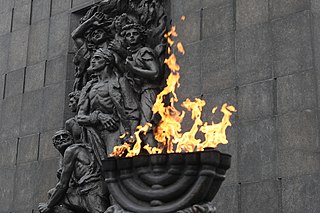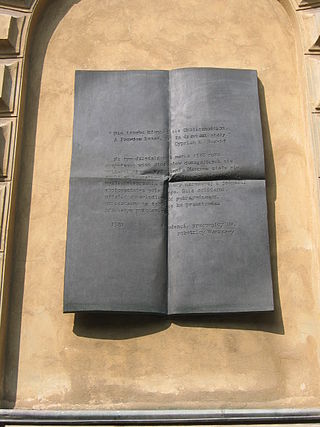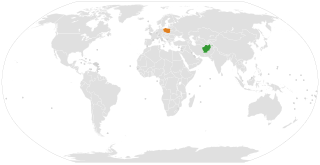
The Eastern Bloc, also known as the Communist Bloc (Combloc), the Socialist Bloc, and the Soviet Bloc, was the coalition of communist states of Central and Eastern Europe, Asia, Africa, and Latin America that were aligned with the Soviet Union and existed during the Cold War (1947–1991). These states followed the ideology of Marxism–Leninism, in opposition to the capitalist Western Bloc. The Eastern Bloc was often called the "Second World", whereas the term "First World" referred to the Western Bloc and "Third World" referred to the non-aligned countries that were mainly in Africa, Asia, and Latin America but notably also included former pre-1948 Soviet ally Yugoslavia, which was located in Europe.

The Polish People's Republic was a country in Central Europe that existed from 1947 to 1989 as the predecessor of the modern-day Republic of Poland. From 1947 to 1952 it was known as the Republic of Poland, and it was also often simply known as Poland. With a population of approximately 37.9 million near the end of its existence, it was the second most-populous communist and Eastern Bloc country in Europe. A unitary state with a Marxist–Leninist government, it was also one of the main signatories of the Warsaw Pact alliance. The largest city and official capital since 1947 was Warsaw, followed by the industrial city of Łódź and cultural city of Kraków. The country was bordered by the Baltic Sea to the north, the Soviet Union to the east, Czechoslovakia to the south, and East Germany to the west.

The Polish Workers' Party was a communist party in Poland from 1942 to 1948. It was founded as a reconstitution of the Communist Party of Poland (KPP) and merged with the Polish Socialist Party (PPS) in 1948 to form the Polish United Workers' Party (PZPR). From the end of World War II the PPR led Poland, with the Soviet Union exercising moderate influence. During the PPR years, the centers of opposition activity were largely diminished, and a socialist system was established in the country.

The history of the Jews in Poland dates back at least 1,000 years. For centuries, Poland was home to the largest and most significant Ashkenazi Jewish community in the world. Poland was a principal center of Jewish culture, because of the long period of statutory religious tolerance and social autonomy which ended after the Partitions of Poland in the 18th century. During World War II there was a nearly complete genocidal destruction of the Polish Jewish community by Nazi Germany and its collaborators of various nationalities, during the German occupation of Poland between 1939 and 1945, called the Holocaust. Since the fall of communism in Poland, there has been a renewed interest in Jewish culture, featuring an annual Jewish Culture Festival, new study programs at Polish secondary schools and universities, and the opening of Warsaw's Museum of the History of Polish Jews.

The Polish government-in-exile, officially known as the Government of the Republic of Poland in exile, was the government in exile of Poland formed in the aftermath of the Invasion of Poland of September 1939, and the subsequent occupation of Poland by Germany, the Soviet Union, and the Slovak Republic, which brought to an end the Second Polish Republic.

The history of Poland from 1945 to 1989 spans the period of Marxist–Leninist regime in Poland after the end of World War II. These years, while featuring general industrialization, urbanization and many improvements in the standard of living, were marred by early Stalinist repressions, social unrest, political strife and severe economic difficulties. Near the end of World War II, the advancing Soviet Red Army, along with the Polish Armed Forces in the East, pushed out the Nazi German forces from occupied Poland. In February 1945, the Yalta Conference sanctioned the formation of a provisional government of Poland from a compromise coalition, until postwar elections. Joseph Stalin, the leader of the Soviet Union, manipulated the implementation of that ruling. A practically communist-controlled Provisional Government of National Unity was formed in Warsaw by ignoring the Polish government-in-exile based in London since 1940.
Following the establishment of the Second Polish Republic after World War I and during the interwar period, the number of Jews in the country grew rapidly. According to the Polish national census of 1921, there were 2,845,364 Jews living in the Second Polish Republic; by late 1938 that number had grown by over 16 percent, to approximately 3,310,000, mainly through migration from Ukraine and the Soviet Russia. The average rate of permanent settlement was about 30,000 per annum. At the same time, every year around 100,000 Jews were passing through Poland in unofficial emigration overseas. Between the end of the Polish–Soviet War of 1919 and late 1938, the Jewish population of the Republic grew by nearly half a million, or over 464,000 persons. Jews preferred to live in the relatively-tolerant Poland rather than in the Soviet Union and continued to integrate, marry into Polish Gentile families, to bring them into their community through marriage, feel Polish and form an important part of Polish society. Between 1933 and 1938, around 25,000 German Jews fled Nazi Germany to sanctuary in Poland.
After the fall of Communism in Poland in 1989, Jewish cultural, social, and religious life has experienced a revival. Many historical issues related to the Holocaust and the period of Soviet domination (1945–1989) in the country – suppressed by Communist censorship – have been reevaluated and publicly discussed leading to better understanding and visible improvement in Polish–Jewish relations. In 1990, there were 3,800 Jews in Poland, 0.01% of Poland’s population, compared to 3,250,000 before 1939. The number had dropped to 3,200 in 2010.

The Polish 1968 political crisis, also known in Poland as March 1968, Students' March, or March events, was a series of major student, intellectual and other protests against the ruling Polish United Workers' Party of the Polish People's Republic. The crisis led to the suppression of student strikes by security forces in all major academic centres across the country and the subsequent repression of the Polish dissident movement. It was also accompanied by mass emigration following an antisemitic campaign waged by the minister of internal affairs, General Mieczysław Moczar, with the approval of First Secretary Władysław Gomułka of the Polish United Workers' Party (PZPR). The protests overlapped with the events of the Prague Spring in neighboring Czechoslovakia – raising new hopes of democratic reforms among the intelligentsia. The Czechoslovak unrest culminated in the Warsaw Pact invasion of Czechoslovakia on 20 August 1968.

The Polish minority in the Czech Republic is a Polish national minority living mainly in the Trans-Olza region of western Cieszyn Silesia. The Polish community is the only national minority in the Czech Republic that is linked to a specific geographical area. Trans-Olza is located in the north-eastern part of the country. It comprises Karviná District and the eastern part of Frýdek-Místek District. Many Poles living in other regions of the Czech Republic have roots in Trans-Olza as well.

Polish October, also known as October 1956, Polish thaw, or Gomułka's thaw, marked a change in the politics of Poland in the second half of 1956. Some social scientists term it the Polish October Revolution, which was less dramatic than the Hungarian Revolution of 1956 but may have had an even deeper impact on the Eastern Bloc and on the Soviet Union's relationship to its satellite states in Central and Eastern Europe.

The 6th World Festival of Youth and Students was held from 28 July to 5 August 1957 in Moscow, capital city of the then Union of Soviet Socialist Republics. The festival attracted 34,000 people from 130 countries. This became possible after the political changes initiated by Nikita Khrushchev. It was the first World Festival of Youth and Students held in the Soviet Union.
After the end of the Second World War, Polish society and culture were subject to significant changes.

Austria–Poland relations are foreign relations between Austria and Poland. The two nations have a very long historical relationship dating back several centuries, which has been complicated throughout most of their history.

The Republic of Poland and Czechoslovakia established relations early in the interwar period, after both countries gained independence. Those relations were somewhat strained by the Polish–Czechoslovak border conflicts over Trans-Olza and Cieszyn in the early 1920s and late 1930s. Both countries joined the Allies during World War II. After the war they both fell into the Soviet sphere of influence. Poland, together with other Eastern Bloc countries, participated in the Warsaw Pact invasion of Czechoslovakia in 1968. Relations between the two countries were nonetheless rather amicable, but became somewhat strained in the aftermath of the rise of the Solidarity movement in Poland in 1980 and 1981, improving again afterwards.

Relations between the People's Republic of China and Poland officially began on October 5, 1949.

The World Federation of Democratic Youth (WFDY) is an international youth organization, and has historically characterized itself as left-wing and anti-imperialist. WFDY was founded in London, United Kingdom in 1945 as a broad international youth movement, organized in the context of the end of World War II with the aim of uniting youth from the Allies behind an anti-fascist platform that was broadly pro-peace, anti-nuclear war, expressing friendship between youth of the capitalist and socialist nations. The WFDY Headquarters are in Budapest, Hungary. The main event of WFDY is the World Festival of Youth and Students. The last festival was held in Sochi, Russia, in October 2017. It was one of the first organizations granted general consultative status with the United Nations Economic and Social Council.
Africans in Poland, also known as Afro-Poles or Afro-Polish, are citizens or residents of Poland who are of African descent. As of 2023, among European countries, the proportion of people from Africa is one of the lowest.

Afghanistan and Poland established diplomatic relations in 1928. Afghanistan has an embassy in Warsaw.

Netherlands–Poland relations is the official relationship between the Kingdom of the Netherlands and Republic of Poland. Both nations are members of the Council of Europe, European Union, NATO and OECD.















